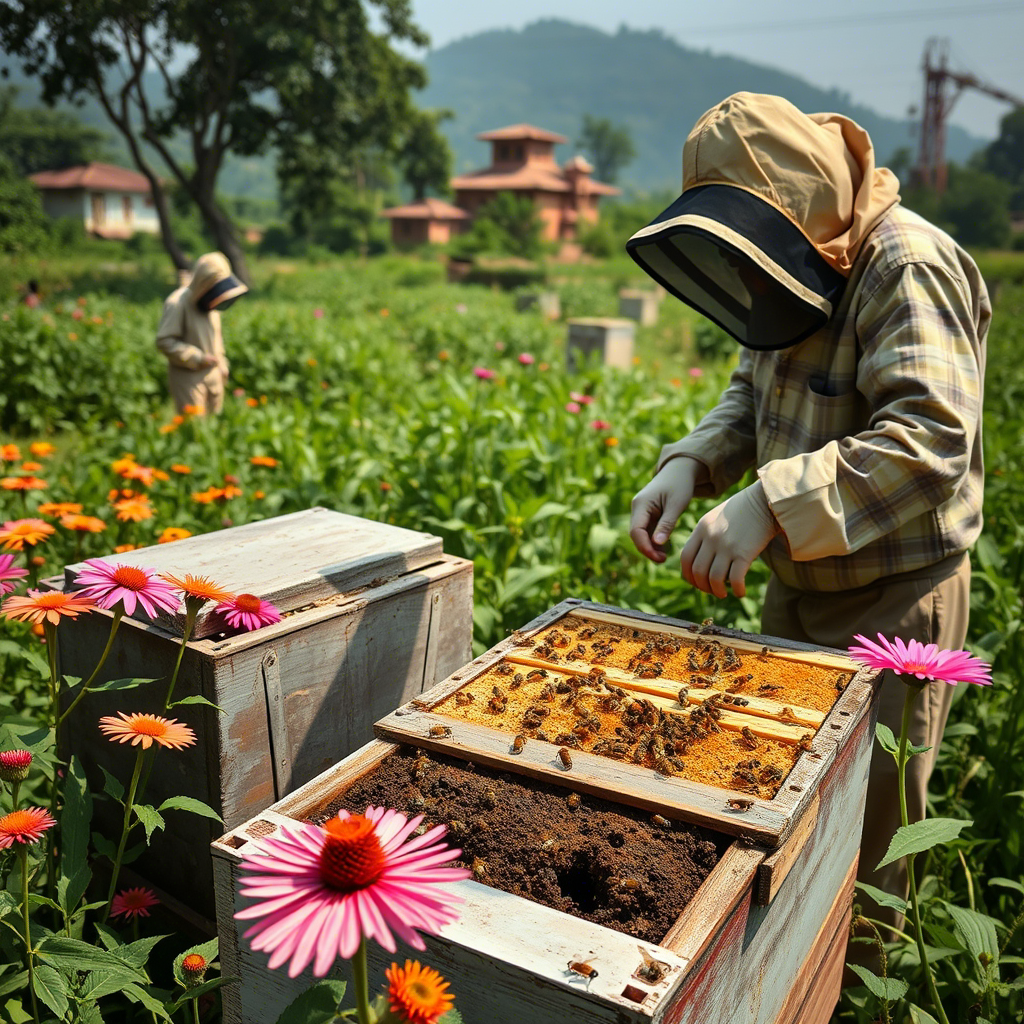Honey Bee Farming in India: A Comprehensive Guide to Management and Business Growth
Introduction
Honey bee farming, or apiculture, is an age-old practice in India, gaining momentum as a sustainable and profitable agribusiness. With diverse flora, a favorable climate, and increasing demand for natural honey and bee products, India holds immense potential for apiculture. The sector not only contributes to agricultural productivity through pollination but also empowers rural livelihoods. This guide explores how to establish, manage, and scale a honey bee farming business in India, addressing challenges and leveraging opportunities.
1. Starting a Honey Bee Farming Business
1.1 Selecting the Right Location
A suitable location is critical. Ideal sites have:
- Abundant flowering plants (e.g., mustard, sunflower, eucalyptus).
- Access to clean water.
- Minimal pesticide use.
- Shelter from extreme weather.
States like Punjab, Uttar Pradesh, Bihar, and Karnataka are popular due to their agricultural landscapes.

1.2 Choosing Bee Species
India hosts four primary honey bee species:
| Species | Characteristics | Honey Yield/Year | Suitability |
|---|---|---|---|
| Apis cerana indica | Indigenous, hardy, moderate yield | 5–8 kg | Small-scale farmers |
| Apis mellifera | European species, high yield | 25–40 kg | Commercial ventures |
| Apis dorsata (Rock bee) | Wild, high yield, aggressive | 35–50 kg | Forest areas, not domesticated |
| Apis florea (Dwarf bee) | Small colonies, low yield | 1–2 kg | Arid regions |
Apis mellifera and cerana are preferred for domestication.
1.3 Essential Equipment and Initial Costs
Startup investments include:
| Equipment | Purpose | Approx. Cost (INR) |
|---|---|---|
| Beehives (Langstroth) | Housing colonies | 2,000–3,000 per hive |
| Protective gear | Suits, gloves, veils | 1,500–3,000 |
| Smoker | Calming bees during inspections | 500–1,000 |
| Honey extractor | Mechanized honey harvesting | 10,000–25,000 |
| Feeders | Supplemental feeding | 200–500 |
| Transportation | Hive migration vehicles | Variable |
Initial setup for 10 hives: ₹1–2 lakhs.
1.4 Training and Registration
- Attend workshops by the National Bee Board (NBB) or KVIC (Khadi and Village Industries Commission).
- Register as an MSME or under FSSAI for honey sales.
2. Managing a Bee Farm
2.1 Seasonal Management
Bee behavior varies seasonally:
| Season | Tasks |
|---|---|
| Spring | Colony expansion, swarm prevention, hive splitting |
| Summer | Provide shade/water, monitor pests, harvest honey |
| Monsoon | Protect hives from rain, control ants/fungus |
| Winter | Supplemental feeding (sugar syrup), reduce hive entrances |
2.2 Disease and Pest Control
Common threats and solutions:
| Pest/Disease | Symptoms | Treatment |
|---|---|---|
| Varroa mites | Weak colonies, deformed bees | Oxalic acid, formic acid |
| Wax moths | Webbed combs, larvae tunnels | Freeze combs, maintain hive hygiene |
| American foulbrood | Foul odor, sunken cappings | Burn infected hives, antibiotics |
| Ants | Hive invasion | Apply cinnamon/chalk around hives |
2.3 Feeding Practices
- Feed sugar syrup (1:1 ratio) during dearth periods.
- Use protein patties (soy flour + pollen) to boost brood production.
2.4 Colony Management
- Regularly inspect hives for queen health and brood patterns.
- Requeen colonies annually to maintain productivity.

3. Scaling the Honey Bee Farming Business
3.1 Increasing Production
- Expand hive numbers gradually (20–50 colonies).
- Adopt migratory beekeeping to follow flowering cycles (e.g., litchi in Bihar, sunflower in South India).
3.2 Value-Added Products
Diversify revenue streams:
| Product | Uses | Market Potential |
|---|---|---|
| Beeswax | Candles, cosmetics, polishes | Domestic and export (₹500–800/kg) |
| Propolis | Health supplements, ointments | Pharmaceutical industry |
| Royal jelly | Dietary supplements, skincare | High-end domestic markets |
| Pollen | Nutrition supplements | Health stores, online |
3.3 Branding and Marketing
- Label products with FSSAI certification and organic tags.
- Sell through e-commerce (Amazon, BigBasket), local stores, or export via APEDA.
- Participate in trade fairs (e.g., India International Honey Fair).
3.4 Government Schemes and Subsidies
| Scheme | Eligibility | Benefits |
|---|---|---|
| National Beekeeping Mission | Farmers, NGOs, SHGs | 40–50% subsidy on equipment, training |
| MSME Loans | Registered small businesses | Low-interest loans up to ₹10 lakhs |
| PMEGP (KVIC) | Rural entrepreneurs | 25–35% subsidy for setup |
4. Challenges and Solutions
| Challenge | Solution |
|---|---|
| Climate change | Migrate hives to cooler regions, plant drought-resistant flora |
| Pesticide poisoning | Collaborate with farmers for organic farming |
| Fake honey competition | Obtain BIS/AGMARK certification, educate consumers |
| Lack of technical knowledge | Partner with NBB, enroll in online courses |
5. Conclusion
Honey bee farming in India offers a sweet spot between ecological impact and economic growth. By adopting modern techniques, diversifying products, and leveraging government support, entrepreneurs can build thriving enterprises. With the global shift toward natural products, India’s apiculture sector is poised for exponential growth, creating opportunities for innovation and sustainability.
Tables Recap
- Bee Species Comparison
- Startup Equipment Costs
- Seasonal Management Tasks
- Pest and Disease Solutions
- Value-Added Products
- Government Schemes
Further Reading
- National Bee Board (NBB) Guidelines
- APEDA Export Manual
- Beekeeping Training Modules by Agricultural Universities
This structured approach ensures a holistic understanding of honey bee farming, empowering aspiring beekeepers to succeed in India’s buzzing apiculture industry.
